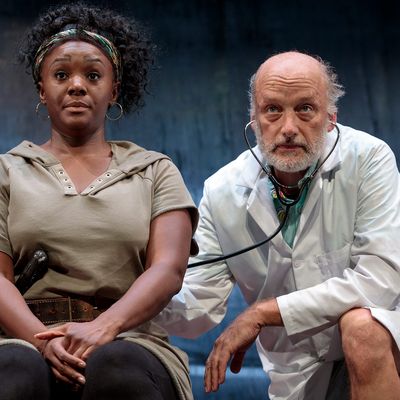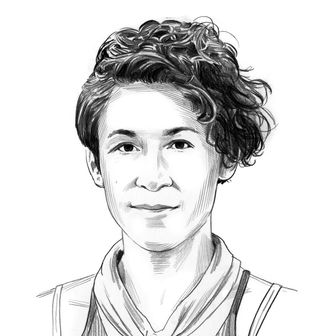
THERE SHE IS!
WHO DOES SHE THINK
SHE IS
THE NERVE SOME PEOPLE HAVE
SHOULDNT HAVE IT IF YOU CANT AFFORD IT
AND YOU KNOW SHE CANT
SHE DONT GOT NO SKILLS
CEPT ONE
CANT READ CANT WRITE ….
THATS WHY THINGS ARE BAD LIKE THEY ARE
CAUSE OF
GIRLS LIKE THAT
She is Hester, the protagonist of Suzan-Lori Parks’s In the Blood. As her story begins, we see her surrounded by an ensemble of jeering, anonymous ensemble members who lob those lines at her. She cradles a newborn child in her arms — one of the five she’s trying to raise, with none of their fathers in sight. She lives in poverty. She is desperate for help but receives only insults, accusations, curses.
In the Blood was first performed in 1999, but in the powerful production now at Signature Theatre, we never forget that we are grappling with the particular horrors of the here and now, facing down the specific breed of resentment and contempt this society reserves for women of color. The play’s heroine is not simply called “Hester” but “Hester La Negrita.” Through her harrowing experience — and that of the Hester in Fucking A, In the Blood’s sister production playing right across Signature’s lobby in the Romulus Linney Courtyard Theatre — Parks rages incisively, articulately, and sometimes even humorously against the capitalist machine that grinds these women down. Both plays are Parks’s variations on the theme of Nathaniel Hawthorne’s The Scarlet Letter, and both feel vital and urgent in the America we’re currently living in, with its crippling economic stratification, bald-faced sexism, and institutionalized white supremacy.
Of the genesis of In the Blood, Parks has said, “I heard a voice … And the voice said, ‘I’ll tell you the story of your play … A woman with five children by five different lovers, that’s your play, and the children and the adults in the play are played by the same adult actors.’” Five kids, and five adult interlopers into Hester’s world. In the Blood follows her efforts to get by and provide for her family while dealing with increasingly threatening incursions by the Doctor (Frank Wood, who also portrays her son Trouble); Welfare (Jocelyn Bioh, also Hester’s daughter Bully); the wheedling hustler Amiga Gringa (Ana Reeder, also her daughter Beauty); the self-serving street preacher and one of Hester’s former lovers Reverend D. (Russell G. Jones, who doubles as D. and Hester’s child Baby); and finally Chilli, Hester’s first love, father of her son Jabber, and a real wolf in Prince Charming’s clothing (Michael Braun, who plays Jabber as well).
In portraying the kids — who range from two to 13 years old — these intelligent and versatile actors are by turns exuberant, touching, and even a little menacing. They are Hester’s “treasures,” her “joys,” but they are also five hungry, volatile, feral creatures. Seeing them manifested in big adult bodies forces us to recognize how heavily they bear down on their mother. Despite their love and need for her, a cloud of menace surrounds them — partly the residue of the adult roles they play, a cast of archetypal and nauseatingly recognizable characters who have all, both figuratively and literally, fucked Hester.
In a series of “confessions” that punctuate the play, each of these adult figures speak directly to us, the audience, in an attempt to justify or rationalize the fact that he or she has taken advantage of Hester in the most invasive and intimate way. It’s not subtle, but Parks isn’t going for subtlety so much as confrontation. We want to feel good about ourselves, to give, to be charitable, but in the caustic words of Reverend D., we don’t want just “any poor.” Instead, we want our poor “on tv … Famous poor, not miscellaneous poor. And I don’t want local poor. Local poor don’t look good. Gimmie foreign poor. Poverty exotica.”
Local poor Hester is a target — for both the “good will” and the perversions of those around her. Of the ensemble, Jocelyn Bioh is particularly effective as Welfare, who wears plastic bags over her pink stilettos when she visits Hester and speaks to us from the warm, fuzzy depths of a cocoon of privilege and self-satisfaction. Her response when Hester mutters the casually awful (and awfully true) observation, “I don’t think the world likes women much” is to shoot back with sassy myopia, “I’m a woman too! And a black woman too just like you. Don’t be silly.”
Don’t be silly, Hester. My hands are tied, Hester. Suck me off, Hester. There are some conditions, Hester. The characters that orbit Hester insidiously pile more and more weight — more and more condescension, judgment, and abuse — upon her, like the psychic equivalent of the towering plastic garbage chute that ascends into the fly space on one side of Louisa Thompson’s set, periodically spewing out filth throughout the play. In the Blood is building toward the moment in which its heroine finally buckles under the load.
As Hester, Saycon Sengbloh gives a performance both innocent and frightening — and finally, devastating. Sengbloh (who won the Drama Desk and Obie Awards and was Tony-nominated for her performance in Eclipsed) brings a cheerful, loving determination to Hester that makes the gradual arc of her story all the more heart-wrenching. Early in In the Blood, she’s so solid and sweet-natured that — as you watch Hester embrace her wild youngsters or make up stories for them or chat encouragingly to herself while she tries to shine their unshineable shoes — you truly feel like her positivity has the power to sustain and perhaps even save her family, like love will make everything okay.
Which is complete bullshit, because things are not okay. Parks and Sengbloh — the one with her wily writing and the other with her deeply sympathetic performance — are revealing just how quickly we slip into complacency. It’s an awful paradox, but because Hester is grateful, docile, uncomplaining — “I been good” she says again and again — we are somehow less inclined to help her. Sengbloh shows us little flashes of the agony and anger accumulating under Hester’s placid surface, and then quickly packs them away again. But we know they’re there, waiting to burst from her.
The ultimate moment of insult and injury comes after a kind of dream ballet with her first lover, Chilli, who waltzes back into Hester’s life after a 13-year absence, carrying a wedding dress and testing the waters for their potential reunion. As Hester slips into the dress, Sengbloh looks like a little girl getting ready for her first big party. Her eyes brim with tears as she whispers a single, awed, gut-wrenching observation: “It’s so clean.” Sengbloh lets us see Hester giving in to the dream and giving up her defenses. She is desperate to be swept off her feet — her heart is practically leaping from her chest in an effort to fly — but we can see that the fall back to Earth will be shattering.
For the Earth of this play is unforgiving and all too familiar. Director Sarah Benson and her skillful design team have brought the harsh texture and soundscape of New York’s streets into Signature’s Alice Griffin Jewel Box Theatre. Metal, concrete, and dirty construction tarps greet us upon entry. Hester’s children rifle through the ever-increasing junk pile underneath the belching garbage chute, pulling out plastic toys that someone else regarded as trash and scuttling off into their burrows with them like squirrels hoarding nuts.
With a concave gray wall that slides down into a floor like a half-pipe, In the Blood’s set is made for movement, and the actors throw themselves into it. I laughed aloud when Hester’s oldest daughter, Bully (Jocelyn Bioh, now full of youthful, nervous bluster), made her first entrance at the top of the wall, shrieking “Mommieeeeeeeee!” as she did a belly-slide straight down onto the stage. Occasionally I found myself wishing that the actors would throw themselves into the rhythms of Parks’s language as intrepidly as they hurl their bodies around the set — especially in the choral sections, the words could cut just a bit more.
While it’s a joy to watch the actors (as Hester’s children) tirelessly flailing against the set’s great wall, there’s also something terrible going on. Benson and scenic designer Louisa Thompson have built a heartbreaking metaphor into their playing space. There’s no reaching the top of the wall. The world that Hester’s family lives in is rigged, purposefully built to force them back to the bottom over and over again. Notably, Hester mostly stays clear of the wall. She’s not a child anymore — something in her recognizes that it’s no game but a Sisyphean trap.
If this sounds grim, trust me, there’s humor here as well. Even when she’s depicting scenes of suffering, Parks is too smart a writer to paint in only dour colors. Like its sister production Fucking A, In the Blood has bright sparks of levity, including the playful performances of Hester’s noisy gaggle of children, a wacky Pas de Deux between Hester and Chilli, and Montana Levi Blanco’s colorful (sometimes even whimsical) costumes. Parks is canny — she knows that laughter opens up the ribs so that later you can slip the knife in.
Something special is happening right now at Signature Theatre. As Parks comes to the close of her tenure with Signature’s Residency One (a program that produces several plays from the body of work of a single writer over the course of a year), In the Blood and Fucking A are being presented simultaneously for the first time. They’re not easy to watch, but they’re vital, scrappy, angry, witty, articulate. They may be almost 20 years old, but make no mistake, the productions currently playing at Signature are proof that these stories belong to our world, right now, today.
In the Blood is at the Signature Theatre Company.





